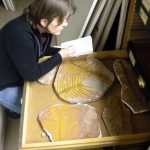
On a cold Berkeley morning late in March paleobotanist Cindy Looy and grad student Susan Tremblay hopped on a plane to Washington DC. Their goal was not to enjoy the gorgeous spring weather and peaking cherry blossoms, but instead to search for clues to the early evolution of plants in the collections of the National Museum of Natural History (NMNH). Devonian liverworts and Permian conifers were on the menu.
Pallaviciniites devonicus, described by Francis Hueber in 1961, is one of the oldest known fossil liverworts. The shale from which the fossils originated, a locality in Eastern New York, has been completely quarried and used for road repairs. Until recently the taxon was thought to exist only in the form of six type slides. However, on a previous visit to the NMNH, Devonian specialist Carol Hotton pointed Cindy to several cabinets with the original shales collected by Hueber. One of our goals was to re-examine the material.
At first glance the shales don’t seem to contain any fossils at all. But when looked at with a stereo microscope using polarized light a variety of plant fossils, including liverwort thalli, become clearly visible. A selection of this material was shipped to the UCMP, where preparations are being made to free the fossils by dissolving the matrix. P. devonicus and other Paleozoic liverwort taxa have dark cells scattered across their surfaces. These are hypothesized to be homologous to the scattered, oil body containing-cells of some extant liverworts. Susan will use morphometrics and biogeochemical information to test possible homology. This might elucidate the evolution and possible function of these mysterious organelles found only in liverworts, the sister group to the rest of the land plants.
Cin’s quest to reconstruct the early history of the Paleozoic conifers also continued. The earliest conifers are small trees with a growth habit similar to that of extant Norfolk Island Pine. They played a prominent role in the composition of plant communities in the equatorial Euramerican floral realm during the Late Carboniferous and Early Permian. Conifers generally fossilize as leaves or isolated shoots, or fragments thereof. The specimens studied were collected by Cindy and NMNH colleagues and originate from an Early Permian seed-plant-dominated flora from Texas. The presence of complete branch systems provides valuable information about the life history of the plants that produced them. New finds from New Mexico were loaned for further study at the Looylab.
